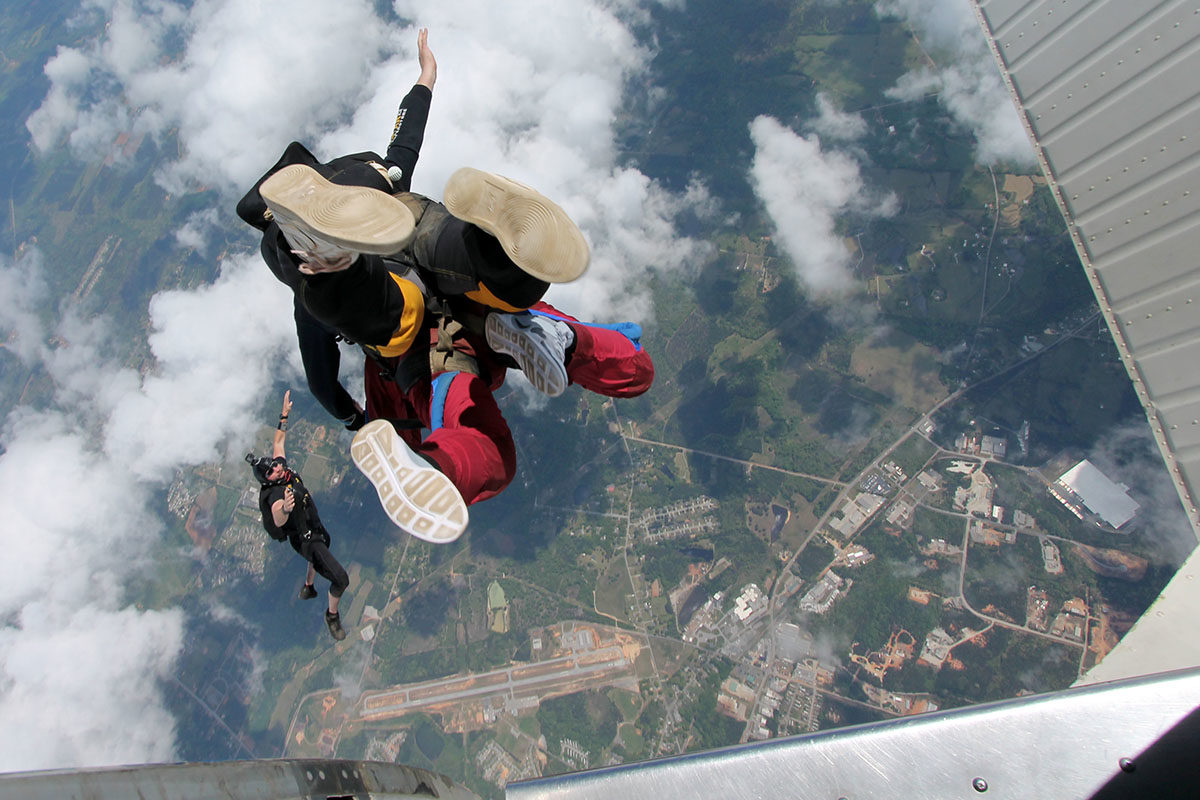Few pieces of technology have impacted the sport of skydiving quite like the Automated Activation Device (AAD) – it has saved thousands of lives. Thanks to the advent of the AAD, parachute, altimeter, and other technological advancements, the risk that is inherent to skydiving is significantly mitigated making the sport more accessible than ever before. But what exactly is an AAD skydiving device and how does it work? Excellent questions – let’s jump into the answers!
What is an AAD in Skydiving?
 “AAD” is the abbreviation for the very official (and descriptively) named Automatic Activation Device. In simple terms, the AAD is a skydiving device that automatically deploys the parachute at a certain altitude if the skydiver has taken no action to deploy it on their own.
“AAD” is the abbreviation for the very official (and descriptively) named Automatic Activation Device. In simple terms, the AAD is a skydiving device that automatically deploys the parachute at a certain altitude if the skydiver has taken no action to deploy it on their own.
To get into the nitty gritty, the AAD is a precise microprocessor computer located within the skydiving container that measures and analyzes a skydiver’s altitude and fall rate using barometric pressure. If a skydiver is falling at a high rate of speed at a low altitude (both pre-programmed into the computer), the AAD will automatically deploy the reserve parachute to avoid a full-speed impact with the ground
Behind the scenes: Why does the AAD need to be on before any skydive? The AAD measures AGL (Above Ground Level) altitude to accurately assess when a jumper has entered the “danger zone” relative to the ground. For this measurement to be accurate, the AAD must be turned on before takeoff so that it can calibrate to zero at ground level.
Types of AADs
There are a few different brands to choose from when purchasing an AAD, but at the end of the day, all of the AADs available pull their weight and have saved countless lives with their technology. The real difference in “type” comes from the AAD settings and what skydiving discipline it will be used for:
- Expert: This is the version most commonly used by licensed skydivers and comes with standard settings appropriate for most sport jumps.
- Student: The student setting alters the speed and altitude settings a bit to be more conservative and deploy under less extreme circumstances to account for the higher possibility of mistakes with people learning how to skydive.
- Tandem: These settings are a step more conservative than the student version and accommodates the higher deployment altitude of tandem skydivers and the larger canopies used for these jumps.
- Speed: This version activates at the highest speed of all AADs because canopy pilots are often intentionally traveling at extremely high speeds close to the ground, and a standard AAD would run the risk of accidental deployment.
- Wingsuit: Wingsuiters drastically alter their freefall speed in a way that could confuse a standard AAD, so this version takes into account the slower fall rate of people wearing wingsuits.
With all of these high-tech choices, you may be wondering, “How much does an AAD cost in skydiving?” They typically cost around $1,200 brand new, which may seem like a lot until you remember that it could save your life one day!
The Role of AADs in Skydiving Safety
Every AAD consists of three main components: a control unit, a processing unit, and a cutter unit.
- Control Unit: The visible part of the AAD that allows skydivers to power the device on and off, access and program the computer, and read data.
- Processing Unit: A mini computer that measures barometric pressure, “makes decisions” based on data, and activates the cutter when necessary.
- Cutter Unit: A small cylinder with a very sharp blade that, when activated, will cut the reserve closing loop and initiate the opening sequence for the reserve parachute.
 Essentially, if the processing unit identifies that a skydiver is still moving at freefall speeds at an unsafe altitude (or above the parameters programmed into the AAD using the control unit), it will activate the cutter unit and deploy the reserve parachute.
Essentially, if the processing unit identifies that a skydiver is still moving at freefall speeds at an unsafe altitude (or above the parameters programmed into the AAD using the control unit), it will activate the cutter unit and deploy the reserve parachute.
To ensure this calculation is exact, as the AAD unit powers up, it calibrates by taking an average value of pressure to determine the current pressure at the ground level. While the AAD is on and in use it will also automatically read the air pressure throughout the day to adjust to current conditions. A mighty smart piece of equipment, huh?
AADs protect skydivers at every level, but one of the most important roles AADs have is protecting tandem jumpers and Accelerated Freefall (AFF) students. It’s easy to get overwhelmed by the sensory overload of learning how to skydive, and an AAD can ensure a new skydiver will have a parachute over their head no matter what happens during the jump. So just how safe is AFF skydiving? We would never say skydiving is “safe” but we can all agree that it is made safer thanks to technology like the AAD!
Skydiving Emergency Procedures and AADs
All AFF students, licensed skydivers, and skydiving instructors are trained to quickly and efficiently conduct skydiving emergency procedures in the event of an issue in the sky. In the unlikely event, that there is a problem with a skydiver’s main parachute, the jumper will initiate their emergency procedures by cutting away the main parachute and deploying the reserve.
In the even more unlikely event that a skydiver cannot complete their emergency procedures, or is unable to deploy their main parachute at the appropriate altitude, the AAD swoops in to save the day. Skydivers never plan to use their AAD – and the chance of an issue or gear malfunction is low – but ensuring it’s ready to fire “just in case” is a crucial part of our safety protocols and emergency procedures.
The AAD is the quiet friend on the shoulder (or back) and is one of the many tools in a skydiver’s bag of emergency backups. This little computer is a critical component for every skydiver’s equipment setup, and all of the gear utilized by students at Skydive Monroe comes equipped with a parachute Automatic Activation Device.
Come and sail across the sunny Georgia sky under an ingeniously engineered and fully equipped parachute – book your skydiving adventure today!
Copyright © 2025, Skydive Monroe, All Rights Reserved.
DropZone Web Design & Marketing by Beyond Marketing, LLC



